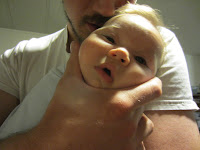 |
| Sweet Sleep! |
So with that glowing endorsement of my skills, let me share with you some of our sleeping tools:
First and foremost, we love Dr. Harvey Karp's 5 S's for not only calming a baby but guiding her to sleep. The 5 S's, as some of you may know, are
- Swaddling: Tight swaddling recreates the confinement of the womb.
- Side/Stomach position: Holding the baby on the right side slightly face down.
- Shushing: Karp uses a loud "ssh" sound similar to the loud white noise that is present in the womb.
- Swinging (and jiggling): Gentle but constant jiggling (especially of the head) is intended to remind babies of the constant motion they experienced in the womb.
- Sucking: Karp also recommends the use of pacifiers.
 |
| "Baby Jedi Mind Trick" in action |
The rest of our techniques aren't really techniques but just information about how babies work.
Babies have different sleep states than adults. Babies start off in the lightest stage of sleep where any slight jostle from the parent can wake them. That's usually why they wake up again as soon as you place them in the crib. The transition from light stages to deeper stages can be tricky as well. Some babies may cry or open their eyes. It's so important to not disturb them as they make that transition. It may seem like good parenting to rush to your baby's side at the sound of the slightest whimper but it tends to actually impede the coveted "sleeping through the night."
In reality, no one sleeps through the night. With varying stages of sleep and wakefulness, "successful" sleepers soothe themselves back to sleep. This is the goal in getting babies to sleep all night. Although, physiologically, a young baby needs to wake up in the night-- more on that later. When we continually interrupt their sleep cycle, we teach them that they always need us to get to the next sleep stage.
Tomorrow I'll talk about sleep cues and the importance of catching them so baby (and you!) can catch some zzzz's.
No comments:
Post a Comment